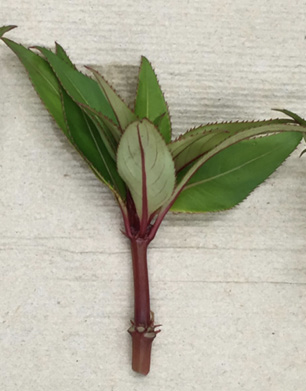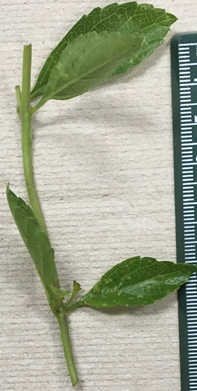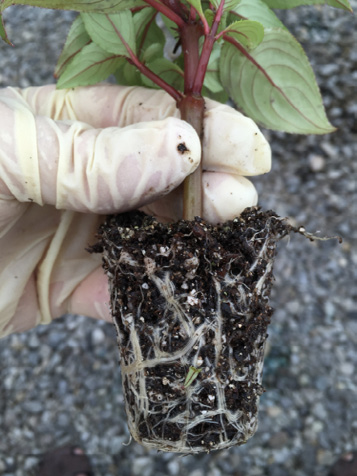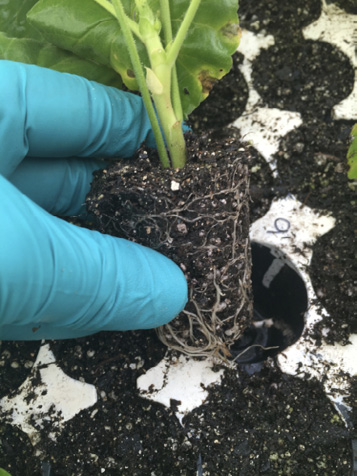Propagating Plants for the Home Landscape
There are several reasons gardeners want to propagate plants rather than purchase them. Sometimes, an avid gardener will share a favorite plant with others through a cutting. Sometimes, plants are not readily available through commercial outlets, such as with old family heirloom plants. Some people may propagate plants simply for the enjoyment and satisfaction of the propagation process. Superior plant cultivars are occasionally selected from the garden and then propagated, which is how many new cultivars are discovered and produced. Home propagation requires time and effort, but it usually results in having less expensive plants to transplant into the home landscape.
Sexual Propagation
Planting seeds is a method of sexual propagation where parents combine genetic materials to produce offspring that are like the parent in many ways but are genetically distinct. Annual plants are often propagated by seed because they mature in one growing season.
Trees and shrubs can be started from seed at a lower cost than purchasing a plant, but it usually takes longer to grow to maturity. Another disadvantage of propagating a tree or shrub from seed is that the new plant will probably be different from the parent plant. For example, trees grown from a Red Delicious apple seed will probably not be like a Red Delicious. The fruit may be better, equal to, or worse than the Red Delicious. The original Red Delicious tree was discovered as a chance seedling.
You may collect certain seeds and save them for the next growing season. Many conditions must be satisfied to do this. Generally, for annual and vegetable plants, wait until the fruit is mature before collecting. For zinnias, wait until the flower petals wither and fall off the plant. The seeds will be at the base of the old petals. For a tomato, wait until the fruit is too ripe to eat and about to fall off the plant.
Remove any remaining pulp from the fruit when collecting vegetable seeds before drying them. Place them in an airtight container and store in a cool, dry place until it is time to plant. Annual seeds can be stored long-term in a ziplock bag in a freezer. Saving seeds is a great way to ensure the continued existence of heirloom flowers and vegetables.
Asexual Propagation
Many landscape plants are propagated by asexual methods where the offspring are genetically like the parent plant. Three methods of plant propagation are cutting, division, and layering. The ideal time of year to propagate depends on the method and type of plants used.
Cuttings
A cutting is any plant part removed from the parent plant and rooted to form a new plant. The cutting can be from the main stem, lateral branch, root, or leaf. Cuttings vary from softwood or herbaceous (current season’s growth) to hardwood (dormant) to semihard wood (after the current season’s growth has hardened).
Softwood Cuttings
New growth should be firm, mature, and slightly brittle. Take 3- to 5-inch cuttings from plants in June, July, and August. Cuttings taken before June are typically too soft and often rot. Cuttings taken after August are usually too woody and take root slowly. Select branches carefully. Test the branch by bending it to a 90-degree angle. If it snaps instead of bending, it is ready for making a softwood cutting. Most softwood cuttings root in 4 to 6 weeks. When roots are about one-half to three-quarters of an inch long, transplant or place into a container for further growth. Plants that root easily from softwood cuttings include azalea, aucuba, crapemyrtle, boxwood, camellia, English ivy, jasmine, holly, photinia, and lantana.
Hardwood Cuttings
Hardwood cuttings are taken during the dormant season or after annual growth has become hardened. Typically, hardwood cuttings are taken in December, January, and February. Cuttings should be from tip growth, about 4 to 8 inches long, with four to six buds per cutting. These usually take longer than softwood cuttings to root but are easier to handle and are less perishable. Plants that root easily from hardwood cuttings include althea, crapemyrtle, forsythia, hydrangea, quince, rose, spirea, and wisteria.
Semi-Hardwood Cuttings
Semi-hardwood cuttings are taken after the current season’s growth has hardened but before going dormant (August through October). Semi-hardwood cuttings are about 3 to 6 inches long, depending on plant species. Do not let semi-hardwood cuttings dry out. Plants that root easily from semi-hardwood cuttings include camellia, holly, and juniper.
Herbaceous Cuttings
Much like softwood cuttings, herbaceous cuttings are easy and fast to root. Take 3- to 5-inch cuttings from non-woody plants, including impatiens, chrysanthemum, coleus, and many others (see Figure 1). Herbaceous cuttings are rooted under the same conditions as softwood cuttings but can be taken anytime from firm, mature growth during the growing season. Rooting hormones are not necessary but can increase chances for a more uniform, heavier root system.


Preparing the Cuttings
Take cuttings early in the morning when plants are turgid due to high water content. Cuttings should be free of disease and insect pests. Make cuttings with clean pruning shears or a sharp knife to achieve a smooth cut that will heal rapidly. Use 70 percent or higher isopropyl alcohol to carefully wipe down pruning tools between plants to decrease the spread of disease.
Cut half an inch below the node on a stem at a slant. Remove the lower half of the foliage, leaving at least one-third of the upper foliage to make food (photosynthesis) and enhance rooting. Always remove flower buds if present. Place the cutting in a rooting medium as soon as possible and keep the cutting moist and cool during preparation. Do not allow the cutting to become dry.
Dip the base of the cutting in a hormone (such as Rootone) to hasten rooting. Place the cuttings in a pot or rooting box with a well-drained rooting medium. Put cuttings about 2 inches apart, and always keep the medium moist. Remember that cuttings have no roots at the start, so keeping cuttings out of direct sunlight in a high-humidity environment is essential. Use a fine mist irrigation system to prevent the rooting medium from becoming too wet.
Rooting Medium
The medium used for rooting cuttings should be free of insects, diseases, and weeds. It should be porous to allow good air exchange and water drainage. Example mixes are one part clean, sharp sand and one part shredded peat moss; one part clean, sharp sand and one part perlite; or one part clean, sharp sand, one part perlite, and one part shredded peat moss. Measure by volume and not by weight. Do not apply fertilizer until the cuttings have a well-established root system (see Figure 2).



How to Make a Propagation Box
Use lumber to make a simple rectangular frame. Side walls should be 1 × 6 inches or 1 × 8 inches. No bottom is necessary. (A box that measures 3 × 4 feet is large enough to hold several hundred cuttings.) Use PVC pipe, reinforcement rods, conduit pipe, or lattice to make bows to hold a clear plastic cover (over the top of the box). This helps raise humidity and prevent cuttings from drying out.
Hardwood cuttings can be placed in an outdoor propagation box or in well-drained soil. Stick cuttings deep, leaving only the top 4 inches exposed. Place the box in a half-sun, well-drained area. Fill the box 5 to 6 inches deep with a rooting medium (see Figure 3).

Division
Propagation by division occurs by separating plant parts, such as rhizomes, bulbs, tubers, suckers, or stolons. Bulbs (daffodils and onions), tubers (Irish potatoes), and rhizomes (cannas and irises) are storage organs of the plant and are usually underground. Suckers arise from the parent plant roots, while stolons are growth extensions of the plant (turf grass and strawberries). Most divisions are best accomplished when the parent plant is dormant, but exceptions exist.
Layering
Another way to propagate is layering, a technique where the cutting stays connected to the parent plant until it has roots. Bend a branch to the soil and dig a shallow trench to bury part of the branch. Cover it with soil and a heavy object (such as a brick) to hold until rooting occurs. Cut the new plants from the parent plant when the roots are well formed. Landscape plants that layer easily include azalea, camellia, Chinese holly, euonymus, Japanese holly, and juniper.
Air-layering is a form of propagation where the branch is not buried. Remove a small piece of bark from the branch, and apply rooting hormone. Wrap a moist peat moss around the wound and add a piece of plastic film to hold the peat moss. Roots will form after 6 to 8 weeks.
There are many methods to choose from when propagating plants. Be sure to select the most efficient option for the type of plant you want to propagate (see Figure 4).

The information given here is for educational purposes only. References to commercial products, trade names, or suppliers are made with the understanding that no endorsement is implied and that no discrimination against other products or suppliers is intended.
Publication 3952 (POD-10-23)
Revised by Jeff Wilson, PhD, Assistant Horticulture Professor, North Mississippi Research and Extension Center, and Tim Ray, Extension Agent II, Harrison County, from an earlier edition by David Tatum, PhD, former Extension Professor, Plant and Soil Sciences.
The Mississippi State University Extension Service is working to ensure all web content is accessible to all users. If you need assistance accessing any of our content, please email the webteam or call 662-325-2262.









